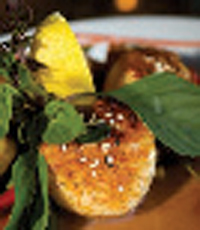It’s not the sexiest diet plan, but logging what you eat can keep you on track
Every year, countless diet books, quick fixes and weight loss pills hit the market promising to get you bikini-ready in no time flat. While diets come and go, one approach is tried-andtrue: keeping a food log. Granted, it’s not making headlines, but it definitely works.
 For starters, journaling what you eat allows you to track your calories. You can see where you’re starting out, how much you’re actually eating, as well as how much you need to cut back. A food log also lets you see what times throughout the day are your toughest and in need of the most improvement. You may realize that you consume the bulk of your day’s calories while you’re cooking dinner or after the kids go to bed, as you’re unwinding for the night.
For starters, journaling what you eat allows you to track your calories. You can see where you’re starting out, how much you’re actually eating, as well as how much you need to cut back. A food log also lets you see what times throughout the day are your toughest and in need of the most improvement. You may realize that you consume the bulk of your day’s calories while you’re cooking dinner or after the kids go to bed, as you’re unwinding for the night.
A food log can help you track your progress and show how far you’ve come. Journaling can encourage you to be more mindful of what you eat, which will help you curb any mindless nibbling.
So how to get started? You can carry a little notebook in your purse or pocketbook, and jot your intake throughout the day. Or you may opt to keep a pretty journal by your bedside and log at night. The only downfall is that you may forget that handful of M&M’s from your co-worker’s desk or those bites of your kids’ leftovers.
If you are tech-savvy you can download a program onto your PDA that will allow you to enter foods throughout the day— any time, any place. And there are free Web sites designed for tracking your food intake as well as your exercise.
Another benefit of the technological approach is that it offers you instant feedback: calories, fat, protein—you name it. Many sites also translate your log into charts and graphs displaying your calories consumed, along with the percentage of carbohydrates, protein, fat and even alcohol.
Two of my personal favorites are www.fitday.com and www.sparkpeople.com. They’re both free and easy to use.
 Thai spicy basil sauce
Thai spicy basil sauce
Courtesy of Diana Chauvin of La Thai Uptown
Serves 6 to 8
4 jumbo sea scallops, pat dry
1/2 tbsp. Tony Chachere’s seasoning
1/2 tsp. paprika
4 jumbo Louisiana gulf shrimp, peeled and deveined
3 tbsp. vegetable oil, divided
2 to 3 cloves garlic, finely chopped
2 shallots, thinly sliced
1/8 cup sliced onion
4 button mushrooms, quartered
4 straw mushrooms
4 asparagus spears, cut into 4 thin slices
1/4 green and red bell pepper, thinly sliced
1 to 2 thai bird chiles (prik kee noo), depending on desired spice, cut into very thin rounds
1 tsp. black soy sauce (semi-sweet kind)
1 tsp. golden mountain seasoning sauce
2 tbsp. fish sauce (nam pla), add salt to taste
1 tsp. sugar
1/2 cup fresh Thai holy basil leaves (bai ka-prow), soaked in tap water 10 to 15 minutes for crispness
Directions: Combine Tony Chachere’s and paprika and coat scallops. Heat a frying pan until surface is smoking hot. Add vegetable oil, swirling to coat the frying pan surface. Wait a few seconds for oil to heat. Place seasoned scallops in pan. Turn scallops over after 2–3 minutes. Repeat on the other side. Should be “perfectly” seared on both sides, until golden brown in color.
Meanwhile, heat wok until surface is smoking hot. Add 1 tbsp. oil, wait to heat up, add garlic. After one minute, add all vegetables and shrimp, then toss in chiles and basil. Sprinkle soy mixture and stir-fry for 15–20 seconds. Season to taste, stir-fry and toss 30 seconds to 1 minute. Stir, then transfer to serving dish. Top with scallops, and serve with steamed jasmine rice, if desired.
Nutrition Facts per Serving:
265 calories; 14 g fat; 0 g trans fat; 15 g carbohydrate; 2 g fiber; 20 g protein 16
